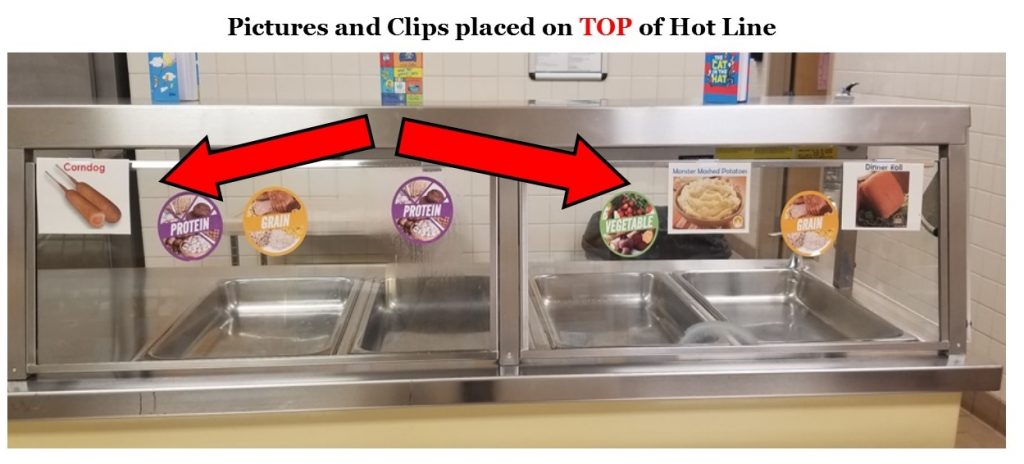
Attractive, eye-catching signage and fun, descriptive food names are effective ways to promote healthy food options to kids. They increase Visibility and Suggestive Selling, two of the behavioral economics principles used by the Smarter Lunchrooms Movement to help lunchrooms promote target foods and increase meal participation. Nanique Gheridian, Assistant School-Based Wellness Coordinator with the School Food Service Department in Palm Beach County, has developed a signage initiative that centers around just that. Fifteen schools in her district so far have started displaying laminated photo cards alongside each item’s name so students know exactly what options are available. Every item now has a corresponding card, from entrees to target foods such as fruits and vegetables. Each laminated card features a representative food image and name. Additionally, Nanique supplies colored clings from the Florida Department of Agriculture that indicate what meal component(s) each item represents, so children can apply what they’ve learned about the importance of selecting nutritionally balanced meals.
The initiative has been well received by Cafeteria Managers. Nanique has received a great deal of positive feedback:
- “The pictures are a big help—thank you! It makes it easier for kids to choose what they want.”
- “I can’t thank you enough for the card library.We love them!! And the kids are noticing!!”
- “The cards are amazing! Thank you for making a difference in the lives of some of our neediest students.”
The photo cards’ benefits are manifold: displaying food images both increases accessibility to students who struggle with reading and provides real-world nutrition education for all. Younger children who are just learning to read or aren’t tall enough to see food options over the lunch line, children with special needs who have sight or communication difficulties, and English language learners alike are all able to look at each item’s image, understand what it is, and simply point to their selection. In fact, some special needs teachers have requested a set of the photo cards to share with their students every day before lunch so they can choose what they’d like before ever getting on the lunch line. The cards also provide children insight into where different foods originate. For example, a card featuring a photo of bagged baby carrots also shows an image of a full carrot with stem, growing in the ground. Likewise, a photo of an apple also shows an apple tree. This allows young and special needs students to make connections between raw ingredients and the finished products they consume on a daily basis. The images help eliminate confusion for all students when options such as hamburgers or sandwiches are wrapped in foil, which can be especially frequent in satellite schools where most food is packaged before arriving at the lunchroom. Additionally, the colored glass clings attached to each image enable students to develop an understanding of what options are in which MyPlate food group, which can help them make more mindful choices.
Interested in creating your own photo food labels? Here’s how.
- Find images that are attractive and accurate representations of each food option. Some options had already been photographed by the School Food Service’s graphic designer, while others Nanique found online. (You can also take photographs of your own meals; if so, use a quality camera and whole-spectrum lighting.) Along with the image and name of each option, you can also add your school’s logo or other form of personalization on each card. You can use this easy template or create your own. Nanique’s library of 135 food cards can be downloaded for free here.
- Print and prepare the cards so that they will last. Nanique prints out four images per 8.5” x 11” piece of cardstock and uses a thicker (3mm) laminate to ensure that they remain sturdy. The laminate is also easy to wipe clean, so maintenance of the cards requires minimal effort. (Note: After cutting the sheet into quarters, putting clear scotch tape around the raw edges can help keep moisture out.)
- If you want to prepare these cards for several schools and can’t perform the labor yourself, outsourcing the work to an office supply store reduces the time commitment. If budget is a concern, request support from school administration, parent groups (PTA, Boosters), or civic groups (rotary clubs, YMCA, community organizations). Tips of community fundraising can be downloaded here. In Nanique’s case, the University of Florida Institute of Food and Agriculture Sciences Extension (UF/IFAS) Palm Beach County Family Nutrition Program assisted in printing and laminating some of the cards and donated clips to attach the cards to the lunch lines, and the Florida Department of Agriculture provided free, 3-4” glass clings whose colors coincide with the MyPlate food groups.
- Distribute the card sets to lunchroom managers in an index card box in alphabetical order so they can easily find the cards they need during meal service. It is a good idea to check the district menus frequently to make sure you have provided a card for each option they have offered. Make new menu cards as needed.
- During service, lunchroom staff can either stick the cards directly on the line equipment (glass or metal) using the clips, tape or glue dots or display the cards onto a menu board. The cards can also encourage kids to try options not often served, such as those during a meal highlighting a specific ethnic cuisine.
A PDF version of this article can be found here.
Contributors
Katie Kuhl & Erin Sharp, Smarter Lunchrooms Movement National Office
Nanique Gheridian, School Food Service Department, Palm Beach County, FL
